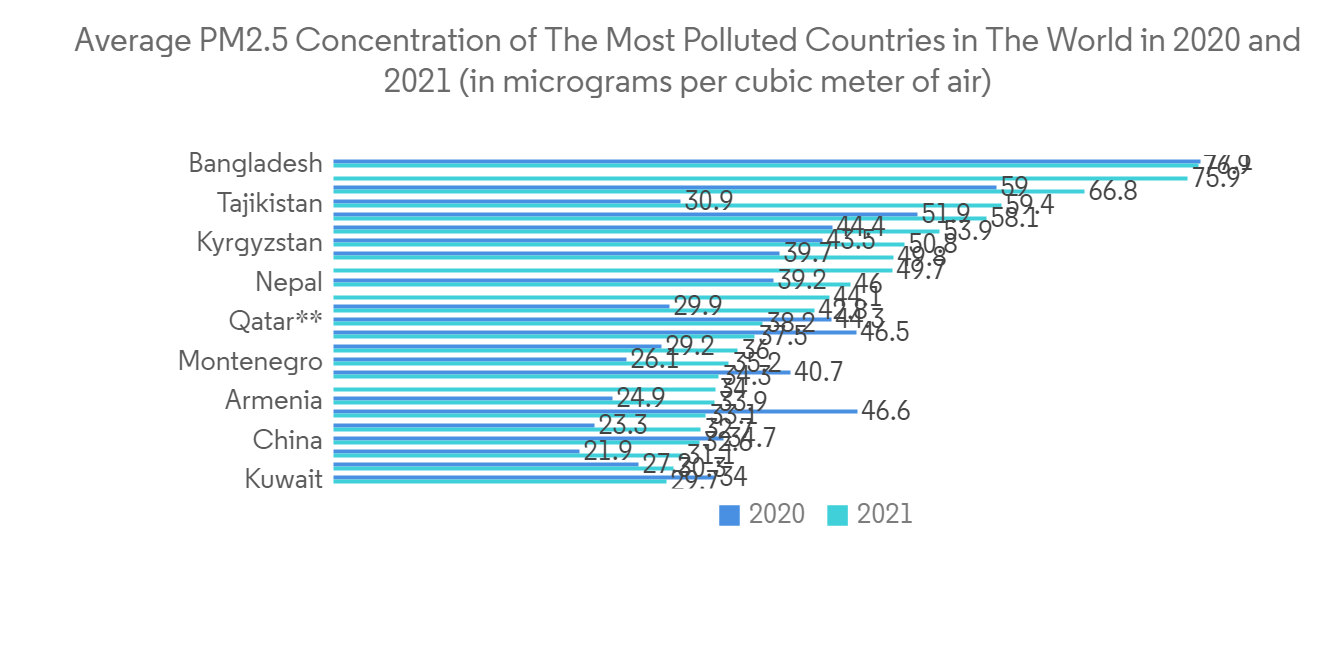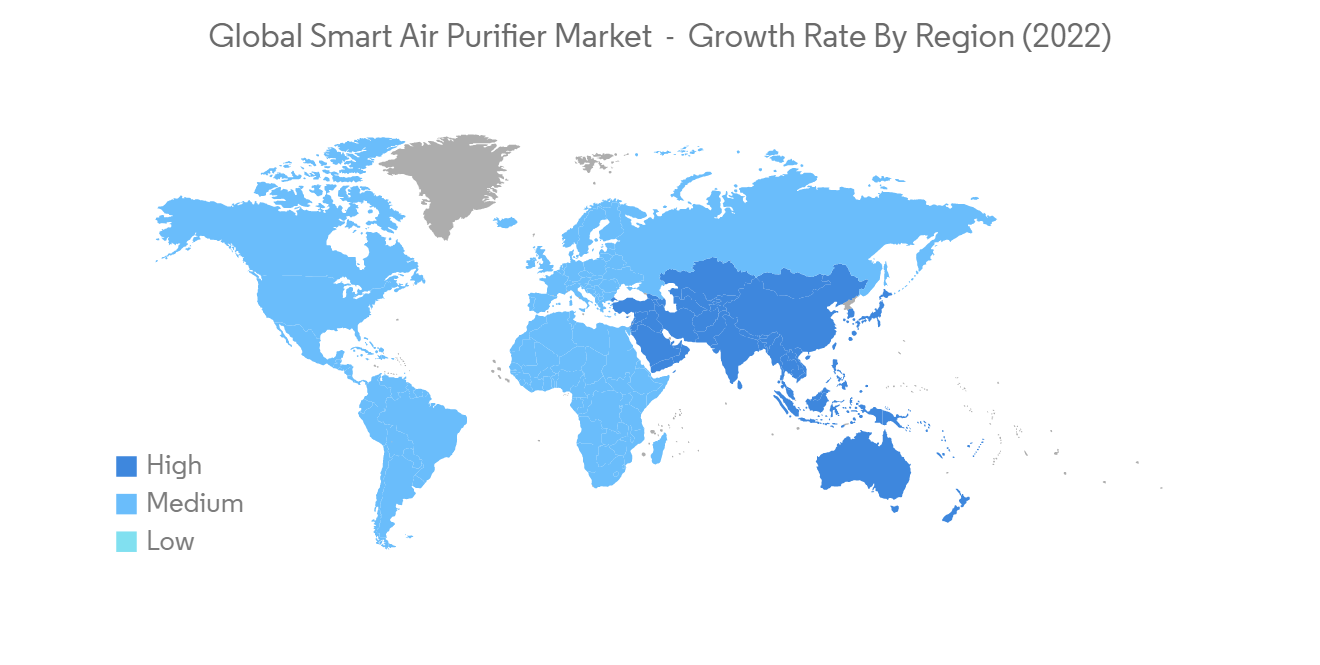 |
市場調査レポート
商品コード
1258784
スマート空気清浄機市場- 成長、動向、予測(2023年-2028年)Smart Air Purifier Market - Growth, Trends, and Forecasts (2023 - 2028) |
||||||
● お客様のご希望に応じて、既存データの加工や未掲載情報(例:国別セグメント)の追加などの対応が可能です。 詳細はお問い合わせください。
| スマート空気清浄機市場- 成長、動向、予測(2023年-2028年) |
|
出版日: 2023年04月14日
発行: Mordor Intelligence
ページ情報: 英文 160 Pages
納期: 2~3営業日
|
- 全表示
- 概要
- 目次
スマート空気清浄機の世界市場は、今年度29億2,000万米ドルの収益を上げ、予測期間には10%のCAGRを達成する予定です。
スマート空気清浄機は、従来の空気清浄機の現代版で、さまざまなエンドユーザーのために自動的に空気をろ過します。Wi-FiやBluetoothなどの無線ネットワークを介してスマート空気清浄機と連携したスマートフォンのアプリを使用することで、遠隔操作することができます。スマート空気清浄機の主な利点は、顧客がスマートフォンを介して室内の空気品質を監視・管理し、基本設定を調整できることです。また、専用の監視センサーから空気質の情報を収集し、そのデータに従って自動的に空気清浄を行い、空気質の変化があった場合はユーザーに警告を発します。
また、スマートフォン用のアプリで空気清浄の設定を微調整するなど、ユーザーによる管理が可能です。スマート空気清浄機は、主に家庭や中小企業、産業ビル、自動車などの屋内で使用・設置されます。スマート空気清浄機は、空気中の煙、ほこり、煙などを自動的に除去する技術を搭載しています。また、安全な化学物質で香りづけされた空気を放出するタイプもあり、環境の雰囲気や香りを高めることができます。
COVID-19の流行により、スマート空気清浄機業界の多くの企業は、病気の蔓延を防ぐことを目的とした政府の新しい規制を遵守するために、一時的に操業を停止することを余儀なくされました。この操業停止は、エアフィルター市場の収益フローに直接的な影響を及ぼしました。さらに、操業停止中の原材料および作業員の不足により、工業製品の生産が停止しました。さらに、この業界の事業者は新たな委託を受けることができなかっています。その結果、産業活動の停止とそれに続く数ヶ月間の封鎖は、スマート空気清浄機の市場シェアに影響を与えましたが、予測期間中に市場は緩やかに回復すると思われます。
都市部は、急速な都市化と建設活動の増加の結果、より一層汚染されるようになりました。スマート空気清浄機のニーズは、環境におけるクリーンで無臭、埃や煙のない空気への要求によってもたらされています。人々は技術志向が強くなり、ハイエンド技術への投資は世界経済の拡大にプラスに働くと予想されます。一人当たりの所得が増加し、医療機器への支出が増加していることから、空気清浄機の売上は今後も増加すると予想されます。
高いメンテナンスコスト、頻繁なフィルター交換、割高な設置費用により、空気清浄機は高価なガジェットとなり、予測期間中の市場成長を阻害しています。
スマート空気清浄機の市場動向
新興国市場における公害の増加が市場を牽引する
中国やインドなどの発展途上国の汚染レベルは非常に高く、これらの国の多くの地域で大気質指数が異常に高くなっています。少なくとも室内の空気を清浄に保つために、特定の地域の住民は空気清浄機を家に設置することが予想されます。
汚染レベルの上昇に伴い、汚染防止製品への需要が高まっているため、市場の拡大が予想されます。近い将来、空気感染する病気の増加により、新興国での製品使用が増加すると予想されます。空気清浄機を使用して空気を浄化することは、家の中の他の場所の掃除にも役立ちます。ホコリには、花粉、カビ胞子、ダニ、皮膚細胞、毛髪、虫くずなどが含まれますが、HEPAフィルターを搭載した空気清浄機では、これらのホコリを捕らえることができます。

アジア太平洋地域が最大のシェアを占める
アジア太平洋地域の市場シェアが最も高く、次いで北米、欧州の順となっています。同地域では工業化が急速に進んでおり、市場需要を牽引しています。アジア太平洋地域の主要市場は、カタール、アラブ首長国連邦、中国、インドです。また、汚染レベルの上昇も市場拡大の原動力となると予想されます。さらに、より健康的なライフスタイルにつながる経済開拓は、市場拡大に好影響を与えます。中東は、予測期間中、世界のその他の地域に大きく貢献すると予想されます。
さらに、各国の汚染レベルの増加により、アジア太平洋は現在、スマート空気清浄機の市場を独占しています。予測期間中、段階的大気質評価対応システムや自動車用排出ガス低減コンバーターのような政策の増加も、スマート空気清浄機市場の発展に寄与するでしょう。健康意識の高まりから、北米はスマート空気清浄機市場でかなりの成長を遂げることが予想されます。さらに、空気の質の基準を引き上げることを目的とした政府の厳しい規則により、この地域のスマート空気清浄機市場は今後数年間で上昇すると予測されています。

スマート空気清浄機の産業概要
メーカーは新技術を駆使して市場に新製品を投入しています。各社は様々なマーケティング戦略を駆使して、市場シェアを拡大しています。市場の大手企業の中には、効率性の向上とコスト削減のために、現在の電子技術やプロセスにおける地位を向上させるために、研究開発活動に多額の投資を行っているところもあります。
その他の特典:
- エクセル形式の市場予測(ME)シート
- 3ヶ月のアナリストサポート
目次
第1章 イントロダクション
- 調査の前提条件と市場の定義
- 調査対象範囲
第2章 調査手法
第3章 エグゼクティブサマリー
第4章 市場力学と洞察
- 市場概要
- 市場促進要因
- 市場抑制要因
- バリューチェーン分析
- 業界の魅力:ポーターのファイブフォース分析
- 新規参入業者の脅威
- 買い手の交渉力
- 供給企業の交渉力
- 代替品の脅威
- 競争企業間の敵対関係の強さ
- 業界における技術的進歩の洞察
- 市場を形成する様々な規制動向に関する洞察
- COVID-19の市場への影響について
第5章 市場セグメンテーション
- タイプ別
- 集塵機
- 集煙機
- その他
- テクノロジー別
- HEPA
- 活性炭ろ過
- その他
- アプリケーション別
- 住宅用
- 商業
- その他
- 流通チャネル
- スーパーマーケット/ハイパーマーケット
- スペシャリティストア
- オンライン
- その他の流通チャネル
- 地域別
- 北米
- 欧州
- アジア太平洋地域
- 南米
- 中東・アフリカ地域
第6章 競合情勢
- 市場集中の概要
- 企業プロファイル
- Sharp Corporation
- Dyson Limited
- Xiaomi Corporation
- Honeywell International, Inc.
- Hamilton Beach Brands, Inc
- Koninklijke Philips NV
- LG Electronics, Inc.(LG Corp)
- Havells India Ltd.
- Sunbeam Products Inc.
- Coway Co., Ltd.
- Levoit(Vesync Co., Ltd.)
- Unilever PLC(Blueair AB)
- Smart Air Filters Pvt Ltd.
- Whirlpool Corporation
- Winix Inc.*
第7章 市場のチャンスと今後の動向
第8章 免責事項およびMordor Intelligenceについて
The Global Smart Air Purifier Market has generated a revenue of USD 2.92 billion in the current year and is poised to achieve a CAGR of 10% for the forecast period.
The smart air purifier is a modern version of a traditional air purifier that automatically filters the air for various end users. It can be controlled remotely by using an app on smartphones linked to smart air purifiers via wireless networks like Wi-Fi and Bluetooth. The main advantage of the smart air purifier is that customers can monitor and manage indoor air quality and adjust basic settings via smartphones. Additionally, these gadgets collect information on air quality from specialized monitoring sensors, automatically clean the air in accordance with that data, and alert users when air quality levels change.
Users can manage these purifiers by fine-tuning the air-cleaning settings using apps designed for smartphones. Smart air purifiers are mostly used and installed in indoor settings, including homes, small businesses and industrial buildings, and automobiles. Smart air purifiers come with technology that automatically removes smoke, dust, and fumes from the air. These gadgets come in versions that release air scented with safe chemicals that can enhance the ambiance and aroma of the environment.
Because of the COVID-19 pandemic, many companies in the smart air purifiers industry were forced to temporarily halt operations in order to comply with new government regulations aimed at preventing disease spread. This halt in operations had a direct impact on the revenue flow of the air filter market. Furthermore, due to a lack of raw materials and workers during the lockdown, industrial product production has ceased. Furthermore, no new consignments were received by businesses in this industry. As a result, the suspension of industrial activities and subsequent lockdown for several months had an impact on smart air purifier market share, and the market is expected to recover slowly during the projection period.
Urban areas have become much more polluted as a result of fast urbanization and increased construction activities. The need for smart air purifiers is being driven by the requirement for clean, odorless, dust- and smoke-free air in the environment. People are now more technologically oriented, and considerable investments in high-end technological items are anticipated to be positive signs for the expansion of the global economy. Due to rising per capita income and spending on medical equipment, it is projected that sales of these air purifiers would continue to climb in the near future.
High maintenance costs, frequent filter replacement, and premium installation fees have made air purifiers an overpriced expensive gadget, impeding market growth in the forecasted period.
Smart Air Purifier Market Trends
Increasing Pollution in Developing Countries Driving the Market
The pollution levels in developing nations like China and India are exceedingly high, and many regions in these nations have exceptionally high air quality index readings. In order to at least maintain clean and fresh indoor air, residents of certain localities are expected to install air purifiers in their houses.
Due to the increased demand for anti-pollution products, as pollution levels rise, the market is anticipated to grow. In the near future, product use is anticipated to increase in emerging nations due to the increased prevalence of airborne illnesses. Using an air purifier to purify the air also aids in cleaning the rest of the house. The airborne particles that make up dust include pollen, mold spores, dust mites, human skin cells, hair, and insect debris; these particles may be captured by air purifiers equipped with a HEPA filter.

Asia-Pacific Held the Largest Share in the Market
The Asia-Pacific region has the largest market share, followed by North America and Europe. The region's rapidly growing industrialization is driving market demand. The major markets in the Asia Pacific are Qatar, the United Arab Emirates, China, and India. Rising pollution levels are also expected to drive Market expansion. Furthermore, economic development that leads to a healthier lifestyle has a positive impact on market growth. The Middle East is expected to contribute significantly to the rest of the world during the forecast period.
Furthermore, due to the growth in pollution levels in various nations, Asia-Pacific now holds a monopoly on the market for smart air purifiers. During the course of the projection period, an increase in policies like the graded air quality rating response system and emission-reducing converters for cars will also help the market for smart air purifiers develop. Due to a surge in health consciousness, North America is expected to have considerable growth in the smart air purifier market. Furthermore, it is projected that the region's market for smart air purifiers would rise in the next years due to the tight government rules intended to raise the standards for air quality.

Smart Air Purifier Industry Overview
The global smart air purifier market is fragmented due to the presence of a large number of global and regional players in the market like Sharp Corporation, Dyson Limited, Xiaomi Corporation, Honeywell International, Inc., Hamilton Beach Brands, Inc., Koninklijke Philips N.V., and LG Electronics, Inc., among others. Manufacturers are introducing new products in the market using new technologies. The companies use various marketing strategies to increase their market shares. Some of the market's leading players are heavily investing in research and development activities to improve their position in current electronic technologies and processes in order to increase efficiency and lower costs.
Additional Benefits:
- The market estimate (ME) sheet in Excel format
- 3 months of analyst support
TABLE OF CONTENTS
1 INTRODUCTION
- 1.1 Study Assumptions and Market Definition
- 1.2 Scope of the Study
2 RESEARCH METHODOLOGY
3 EXECUTIVE SUMMARY
4 MARKET DYNAMICS AND INSIGHTS
- 4.1 Market Overview
- 4.2 Market Drivers
- 4.3 Market Restraints
- 4.4 Value Chain Analysis
- 4.5 Industry Attractiveness: Porter's Five Forces Analysis
- 4.5.1 Threat of New Entrants
- 4.5.2 Bargaining Power of Buyers
- 4.5.3 Bargaining Power of Suppliers
- 4.5.4 Threat of Substitutes
- 4.5.5 Intensity of Competitive Rivalry
- 4.6 Insights into Technological Advancements in the Industry
- 4.7 Insights on Various Regulatory Trends Shaping the Market
- 4.8 Impact of COVID-19 on the Market
5 MARKET SEGMENTATION
- 5.1 By Type
- 5.1.1 Dust Collectors
- 5.1.2 Fume & Smoke Collectors
- 5.1.3 Others
- 5.2 By Technology
- 5.2.1 HEPA
- 5.2.2 Activated Carbon Filtration
- 5.2.3 Others
- 5.3 By Application
- 5.3.1 Residential
- 5.3.2 Commercial
- 5.3.3 Others
- 5.4 Distribution Channel
- 5.4.1 Supermarkets/Hypermarkets
- 5.4.2 Specialty Stores
- 5.4.3 Online
- 5.4.4 Other Distribution Channels
- 5.5 By Geography
- 5.5.1 North America
- 5.5.2 Europe
- 5.5.3 Asia-Pacific
- 5.5.4 South America
- 5.5.5 Middle-East and Africa
6 COMPETITIVE LANDSCAPE
- 6.1 Market Concentration Overview
- 6.2 Company Profiles
- 6.2.1 Sharp Corporation
- 6.2.2 Dyson Limited
- 6.2.3 Xiaomi Corporation
- 6.2.4 Honeywell International, Inc.
- 6.2.5 Hamilton Beach Brands, Inc
- 6.2.6 Koninklijke Philips NV
- 6.2.7 LG Electronics, Inc.(LG Corp)
- 6.2.8 Havells India Ltd.
- 6.2.9 Sunbeam Products Inc.
- 6.2.10 Coway Co., Ltd.
- 6.2.11 Levoit (Vesync Co., Ltd.)
- 6.2.12 Unilever PLC (Blueair AB)
- 6.2.13 Smart Air Filters Pvt Ltd.
- 6.2.14 Whirlpool Corporation
- 6.2.15 Winix Inc.*
